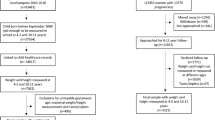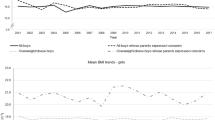Abstract
Background
Childhood obesity has become a major health problem in children under the age of 5 years. Providing reference standards would help paediatricians to detect and/or prevent health problems related to both low and high levels of body mass and to central adiposity later in life. Therefore, the aim of this study was to examine the prevalence of different weight status categories and to provide sex- and age-specific anthropometry reference standards for Spanish preschool children.
Methods
A total of 3178 preschool children (4.59±0.87 years old) participated in this study. Prevalence of different degrees of obesity (mild, severe, and morbid) and other weight status categories were determined.
Results
Reference standards were obtained. Prevalence of overweight and obese preschool children in the Spanish population ranged from 21.4 to 34.8%. Specifically, the obesity prevalence was 3.5, 1.2, and 1.3% of these subjects were categorized as mild, severe, and morbid obese. Sex- and age-specific reference standards for anthropometric parameters are provided for every 0.25 years (i.e. every trimester of life).
Conclusion
Our results show a high prevalence of overweight/obese preschoolers. The provided sex- and age-specific anthropometric reference standards could help paediatricians to track and monitor anthropometric changes at this early stage in order to prevent overweight/obesity.
Similar content being viewed by others
Log in or create a free account to read this content
Gain free access to this article, as well as selected content from this journal and more on nature.com
or
References
Mayer, M. et al. Weight and body mass index (BMI): current data for Austrian boys and girls aged 4 to under 19 years. Ann. Hum. Biol. 42, 45–55 (2015).
Cole, T. J. & Lobstein, T. Extended international (IOTF) body mass index cut-offs for thinness, overweight and obesity. Pediatr. Obes. 7, 284–294 (2012).
WHO Multicentre Growth Reference Study Group. WHO Child Growth Standards based on length/height, weight and age. Acta Paediatr. 450, 76–85 (2006).
Ahrens, W. et al. Prevalence of overweight and obesity in European children below the age of 10. Int. J. Obes. (2005) 38(Suppl. 2), S99–S107 (2014).
World Health Organization. Global Strategy on Diet, Physical Activity and Health (2016). http://www.who.int/dietphysicalactivity/childhood/en/. Accessed 31 Aug 2017.
de Onis, M., Blossner, M. & Borghi, E. Global prevalence and trends of overweight and obesity among preschool children. Am. J. Clin. Nutr. 92, 1257–1264 (2010).
Cadenas-Sanchez, C. et al. Prevalence of overweight/obesity and fitness level in preschool children from the north compared with the south of Europe: an exploration with two countries. Pediatr. Obes. 11, 403–410 (2015).
Bluher, S. et al. Age-specific stabilization in obesity prevalence in German children: a cross-sectional study from 1999 to 2008. Int. J. Pediatr. Obes. 6, e199–e206 (2011).
Olds, T. et al. Evidence that the prevalence of childhood overweight is plateauing: data from nine countries. Int. J. Pediatr. Obes. 6, 342–360 (2011).
Ortega, F. B., Ruiz, J. R. & Labayen I. Trends in the prevalence of morbid obesity in Australian children and adolescents from 1985 to 2008: what do we know about? Int. J. Obes. 35, 1332–1333 (2005).
Wake, M. et al. Morbidity patterns among the underweight, overweight and obese between 2 and 18 years: population-based cross-sectional analyses. Int. J. Obes. 37, 86–93 (2005).
de Onis, M., Blossner, M., Borghi, E., Frongillo, E. A. & Morris, R. Estimates of global prevalence of childhood underweight in 1990 and 2015. JAMA 291, 2600–2606 (2004).
Rito, A. et al. Prevalence of obesity among Portuguese children (6-8 years old) using three definition criteria: COSI Portugal, 2008. Pediatr. Obes. 7, 413–422 (2012).
de Ruiter, I., Olmedo-Requena, R., Sanchez-Cruz, J. J. & Jimenez-Moleon, J. J. Trends in child obesity and underweight in Spain by birth year and age, 1983 to 2011. Rev. Esp. Cardiol. 70, 646–655 (2017).
Duran, P. et al. Colombian reference growth curves for height, weight, body mass index and head circumference. Acta Paediatr. 105, e116–e125 (2016).
Wells, J. C. et al. Body-composition reference data for simple and reference techniques and a 4-component model: a new UK reference child. Am. J. Clin. Nutr. 96, 1316–1326 (2012).
Moreno, L. A. et al. Body fat distribution reference standards in Spanish adolescents: the AVENA Study. Int. J. Obes. 31, 1798–1805 (2007).
Nagy, P. et al. Percentile reference values for anthropometric body composition indices in European children from the IDEFICS study. Int. J. Obes. 38(Suppl. 2), S15–S25 (2014).
Ahrens, W. et al. Metabolic syndrome in young children: definitions and results of the IDEFICS study. Int. J. Obes. (2005) 38(Suppl. 2), S4–S14 (2014).
Bervoets, L. & Massa, G. Defining morbid obesity in children based on BMI 40 at age 18 using the extended international (IOTF) cut-offs. Pediatr. Obes. 9, e94–e98 (2014).
World Health Organization. WHO Child Growth Standards: Length/Height-for-Age, Weight-for-Age, Weight-for-Length, Weight-for-Height and Body Mass Index-for-Age: Methods and Development (World Health Organization, Geneva, 2006).
Glaz, J. & Sison, C. P. Simultaneous confidence intervals for multinomial proportions. J. Stat. Plan Inference 82, 251–262 (1997).
Signorell, A et al. DescTools: Tools for descriptive statistics. R package version 0.99.26 (2018).
Rigby, R. A. & Stasinopoulos, D. M. Generalized additive models for location, scale and shape. J. R. Stat. Soc. Ser. C 54, 507–554 (2005).
van Buuren, S. & Fredriks, M. Worm plot: a simple diagnostic device for modelling growth reference curves. Stat. Med. 20, 1259–1277 (2001).
Intemann, T. P. H., Herrmann, D., Ahrens, W., Pigeot, I. in: Analysis of Large and Complex Data. Studies in Classification, Data Analysis, and Knowledge Organization (eds Wilhelm, A. F. & Kestler, H. A.) 385–394 (Springer International Publishing, Heidelberg, 2016).
Team R. C. [Internet]. R.: A Language and Environment for Statistical Computing. https://www.R-project.org/.
Gulias-Gonzalez, R. et al. Excess of weight, but not underweight, is associated with poor physical fitness in children and adolescents from Castilla-La Mancha, Spain. Eur. J. Pediatr. 173, 727–735 (2014).
Ortega, F. B. et al. Health inequalities in urban adolescents: role of physical activity, diet, and genetics. Pediatrics 133, e884–e895 (2014).
Ruiz, J. R. et al. Objectively measured physical activity and sedentary time in European adolescents: the HELENA study. Am. J. Epidemiol. 174, 173–184 (2011).
Statistic NIo. Population Statistics by Age and Sex (2016). https://stats.oecd.org/index.aspx?DataSetCode=RPOP. Accessed 16 Sep 2016.
Lakshman, R., Elks, C. E. & Ong, K. K. Childhood obesity. Circulation 126, 1770–1779 (2012).
Twig, G. et al. Diabetes risk among overweight and obese metabolically healthy young adults. Diabetes Care 37, 2989–2995 (2014).
Abdullah, A. et al. The number of years lived with obesity and the risk of all-cause and cause-specific mortality. Int J. Epidemiol. 40, 985–996 (2011).
Rolland-Cachera, M. F., Deheeger, M., Maillot, M. & Bellisle, F. Early adiposity rebound: causes and consequences for obesity in children and adults. Int J. Obes. 30(Suppl. 4), S11–S17 (2006).
Bornhorst, C. et al. Associations between early body mass index trajectories and later metabolic risk factors in European children: the IDEFICS study. Eur. J. Epidemiol. 31, 513–525 (2016).
Brambilla, P., et al. Crossvalidation of anthropometry against magnetic resonance imaging for the assessment of visceral and subcutaneous adipose tissue in children. Int. J. Obes. 30, 23–30 (2006).
Acknowledgements
We thank the participation of the preschoolers, parents, and teachers in this study. We are grateful to Ms. Carmen Sainz-Quinn for assistance with the English language. This work is part of a Ph.D. Thesis conducted in the Biomedicine Doctoral Studies of the University of Granada, Spain. The PREFIT project takes place owing to the funding of the Ramón y Cajal grant held by FBO (RYC-2011-09011). C.C.-S. is supported by a grant from the Spanish Ministry of Economy and Competitiveness (BES-2014-068829). E.G.A. and F.B.O. are supported by a grant from the Spanish Ministry of Science and Innovation (RYC-2014-16390 and RYC-2011-09011, respectively). C.A.-B., A.P.-B., and G.S.-D. are supported by the Spanish Ministry of Education (FPU13/03137, FPU15/05337, and FPU13/04365, respectively). Additional funding was obtained from the University of Granada, Plan Propio de Investigación 2016, Excellence actions: Units of Excellence; Unit of Excellence on Exercise and Health (UCEES) and by the Junta de Andalucia, Consejería de Conocimiento, Investigación y Universidades. In addition, funding was provided by the SAMID III network, RETICS, the PN I+D+I 2017-2021 (Spain), ISCIII-Sub-Directorate General for Research Assessment and Promotion, the European Regional Development Fund (ERDF) (RD16/0022, SOMM17/6107/UGR), the EXERNET Research Network on Exercise and Health in Special Populations (DEP2005-00046/ACTI), the University of the Basque Country (GIU14/21), and the University of Zaragoza (JIUZ-2014-BIO-08).
Author information
Authors and Affiliations
Consortia
Contributions
Substantial contributions to conception and design, acquisition of data, or analysis and interpretation of data: C.C.-S., T.I., I.L., C.A.-B., J.S.-M., P.J.B., M.R.B.-V., A.P.-B., G.S.-D., P.P., G.V.-R., and F.B.O. Drafting the article or revising it critically for important intellectual content: C.C.-S., T.I., I.L., C.A.-B., J.S.-M., P.J.B., M.R.B.-V., A.P.-B., G.S.-D., P.P., G.V.-R., L.A.M., and F.B.O. Final approval of the version to be published: C.C.-S., T.I., I.L., C.A.-B., J.S.-M., P.J.B., M.R.B.-V., A.P.-B., G.S.-D., P.P., G.V.-R., L.A.M., and F.B.O.
Corresponding author
Ethics declarations
Competing interests
The authors declare no competing interests.
Additional information
Publisher’s note: Springer Nature remains neutral with regard to jurisdictional claims in published maps and institutional affiliations.
See Supplementary information for a complete list of the PREFIT project members.
Rights and permissions
About this article
Cite this article
Cadenas-Sanchez, C., Intemann, T., Labayen, I. et al. Prevalence of severe/morbid obesity and other weight status and anthropometric reference standards in Spanish preschool children: The PREFIT project. Pediatr Res 87, 501–510 (2020). https://doi.org/10.1038/s41390-019-0325-8
Received:
Revised:
Accepted:
Published:
Issue date:
DOI: https://doi.org/10.1038/s41390-019-0325-8



